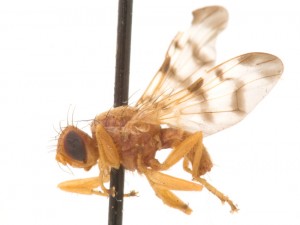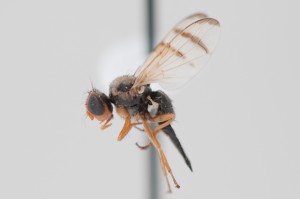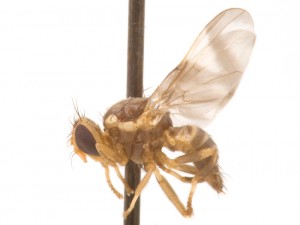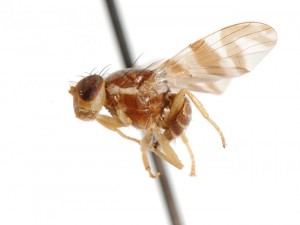With new identification aids, entomological collections begin to give up all manner of hidden treasures. The “Miscellaneous” drawers are no longer out of reach, and determining the species found in your own backyard (sometimes literally) can result in surprising finds.
Rhagoletis meigenii is an introduced species from Europe which infests fruits of European barberry (Barberis vulgaris) as larvae. This species had previously been recorded in North America as early as 1986, but after examining specimens from the Lyman Entomological Museum and here at the University of Guelph Insect Collection, I found specimens collected as early as 1956 in Montreal, Quebec and 1977 in Oakville, Ontario! This indicates that it had made it’s way to North America much earlier than previously thought, and either spread extremely rapidly across eastern North America, or had multiple introduction events! Luckily this species isn’t of economic concern (European barberry fruits are eaten and used in jams in Europe, but the plant harbours wheat rust and is considered noxious in North America), but it indicates how easily a non-native species can slip into a new area unnoticed by scientists and society.
Not all fruit flies enter North America “illegally” though. All three species of Urophora found in Ontario are native to Europe, but were intentionally introduced to help control unwanted, invasive knapweed species. Two of the species introduced became established and quickly spread through southern Ontario (Urophora cardui and Urophora quadrifasciata) while one species didn’t appear to survive. Urophora affinis was experimentally introduced in western Canada where it seemed to thrive, but after release in the early 1980’s at a research plot in Hastings County it failed to be found the next few years, leading the researcher to assume the population hadn’t survived the winter. But, a fly collected 250 km away and more than 20 years later in Simcoe County made it through the curatorial stream, and low-and-behold it was Urophora affinis! Apparently this species did in fact survive the winter, and managed to spread at low population density across central Ontario.
Finding flies thought to be gone is unfortunately not as unlikely as it may seem. Rhagoletotrypeta rohweri is a rarely collected species that hadn’t been seen since 1962. Or at least it hadn’t been thought to have been seen since then! The University of Guelph Insect Collection actually has 4 specimens collected between 1978 and 1985 around Point Pelee National Park. Hopefully this is evidence that this species is still clinging to existence in small pockets of eastern North America!
To round out some of the important species uncovered during this study, here’s Rhagoletis chionanthi. This species had previously only been recorded from North Carolina and Florida, making it’s presence in Ontario a significant expansion of its natural range! Of course this also begs the question as to what it’s using for a larval habitat; the only recorded host plant for R. chionanthi is Chionanthus virginicus (see what they did there, naming the species after its host? Crafty taxonomists…), a plant species which hasn’t been recorded from Canada yet! So what may be happening here? Has the plant expanded it’s range into Canada, bringing it’s pest with it? Or does Rhagoletis chionanthi have multiple hosts? Of course, the apple maggot fly, Rhagoletis pomonella, actually underwent a host-shift from hawthorn to apples when the latter were cultivated in North America, so perhaps Rhagoletis chionanthi has undergone a similar host-shift which we aren’t aware of!
Of course none of these records would have been possible without the entomological collections housed at universities or under provincial or federal care. At a time when taxonomy and natural history collections are devastatingly under funded (or threatened with military take-over), their intrinsic value is made clear through faunistic studies such as this. Who knows what other treasures are awaiting discovery in entomological collections, both large and small? New species await description, rare species make surprise appearances, and the dynamics between species and geography are unfolding with every study!





Great post Morgan, chock full of great info and support for the taxonomic cause!
Good stuff, Morgan.
A host shift is possible… or the species has always utilized multiple hosts (any other species of Oleaceae in Canada?).
I’m not so keen now on naming species after their host. I did it with a buprestid beetle, since all of the specimens had been reared from river birch (Betula nigra), then shortly afterwards reared it from a completely unrelated plant (Ostrya virginiana). We know so little!
Thanks Ted. Excellent warning for future taxonomists about naming after hosts! I’m not a fan of it personally because of the exact scenario you mentioned; even worse is if the taxonomy of the host changes and you’re left with a seemingly random name!
Thats a great post Morgan! I imagine that there are a lot of cases like Urophora affinis were the population density is so low that our chances of documenting a specimen are slim. We assume that a species has been extirpated while there are actually tiny pockets of habitat that are supporting small populations. Your post does provide a good reminder why the situation in Hungary is so depressing and potentially damaging to so many fields of science. I’m not usually a fly guy but who can resist rare bugs of any sort!
Great post, but more importantly fantastic work. Keep it up!